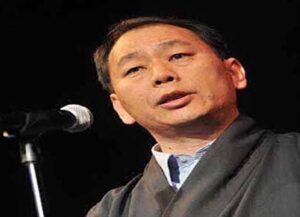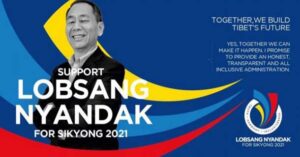 PROFILE:
PROFILE:
• Born in Kalimpong in 1965
Education:
• Attended the Central School for Tibetans (Herbertpur)
• Earned his BA and B.Ed at Panjab University
Work History:
• General Secretary of the Regional Tibetan Youth Congress of Chandigarh (1988-1989)
• Executive, Joint, and General Secretary of the Tibetan Youth Congress (1990-1995)
• Executive Director of the Tibetan Center for Human Rights and Democracy (1996-2001)
• Member of Parliament of the Central Tibetan Administration (CTA) (1996-2001)
• Minister (Kalon) of Finance (2001-2006), Health (2001-2005), and International Relations (2005-2006) in the CTA
• Representative of His Holiness the Dalai Lama to the Americas (2008-2013)
• Member of the Task Force of the Sino-Tibetan Dialogue (2005-2006, 2012-)
• Executive Director (2013-2018) and President (2018-) of the Tibet Fund
Key Points:
• Lead an administration based on “truth, harmony, and inclusiveness”
• Reestablish dialogue with the Chinese government and find a solution honoring the Middle Way Approach
• Uphold the institution of His Holiness the Dalai Lama to sustain Tibetan people’s spiritual hope and unity
• Protect the democratic foundations of the CTA
• Bring peace to Tibet for Tibetan people and for the stability of the region and the world
Alluding to his vibrant, thirty year service to the Tibetan people, President of the Tibet Fund Lobsang Nyendak believes he possesses the right skills and expertise to fulfill the forthcoming Sikyong position. Following the confirmation of his candidacy earlier in March, Nyendak proceeded to announce his campaign points on his website this summer under the slogan, “Together, We Build Tibet’s Future.”
 At the core of his political vision, Nyendak vows to uphold the key principles of “truth, harmony and inclusiveness” while in the Sikyong office. He outlines the importance of each of these principles on his website along with how their necessities have been revealed in the ongoing COVID-19 pandemic. Regarding the principle of truth, he explains that the pandemic has illustrated the importance of “transparency […in fostering] people’s trust in our government,” and that it is precisely the Tibetan people’s trust in the Tibetan government that can “strengthen our leadership and make our CTA more effective.” Nyendak argues that the pandemic has also revealed the danger of political and societal division during crises like these, and hence, “Tibetans must be united and promote harmony in order for us to win our struggles.” Finally, referring to the increasing diversity of “ages, genders, and political viewpoints” within the Tibetan population abroad, Nyendak adds the importance of inclusiveness, in addition to truth and harmony, for both the policymaking of the CTA and the freedom movement of the Tibetan people.
At the core of his political vision, Nyendak vows to uphold the key principles of “truth, harmony and inclusiveness” while in the Sikyong office. He outlines the importance of each of these principles on his website along with how their necessities have been revealed in the ongoing COVID-19 pandemic. Regarding the principle of truth, he explains that the pandemic has illustrated the importance of “transparency […in fostering] people’s trust in our government,” and that it is precisely the Tibetan people’s trust in the Tibetan government that can “strengthen our leadership and make our CTA more effective.” Nyendak argues that the pandemic has also revealed the danger of political and societal division during crises like these, and hence, “Tibetans must be united and promote harmony in order for us to win our struggles.” Finally, referring to the increasing diversity of “ages, genders, and political viewpoints” within the Tibetan population abroad, Nyendak adds the importance of inclusiveness, in addition to truth and harmony, for both the policymaking of the CTA and the freedom movement of the Tibetan people.
Lobsang Nyendak also outlines three objective goals of his leadership on the campaign website. First and foremost, he aims to reestablish dialogue with the Chinese government and find harmonious ways in which the Tibetan issue can be resolved long-lastingly. With reference to his experiences in facilitating Sino-Tibetan conversation as a member of the CTA’s Task Force of the Sino-Tibetan Dialogue, he voices confidence in his ability to restore this contact. In finding a lasting solution, he expresses his intention to stand by the Middle Way Approach*, honouring it as “the vision set by His Holiness the Dalai Lama and the policy adopted democratically by the CTA.”
The second objective brought forward by Nyendak is the strengthening and promotion of His Holiness the Dalai Lama’s institution. He explains that this will “provide a continued spiritual compass and stability for those of our faith around the world and keep alive the hope and unity of the Tibetan people.” In his third objective, pointing to current times when “democracies around the globe are facing threats,” he reiterates his intention to sustain and protect the democratic institutions of the Tibetan people.
At heart, Lobsang Nyendak’s ambition is to settle the Tibetan issue for the virtue of the Tibetan people and the world at a larger scale. He describes this vision of Tibet as “a zone of peace that not only ensures happiness and freedom for our people, but also potentially brings peace and stability to the region and the world.” Importantly, he also warns of a time limit in achieving this vision, signalling that the next ten years will be pivotal for the prosperity of the freedom movement. In contention for this movement’s political leader, he believes that his fruitful experiences in serving the Tibetan people at the grassroot, administrative and international stage “have prepared [him] well to take on any challenges on a national level, and to help [Tibet] thrive politically, socially, culturally and economically.”
*The Middle Way Approach (MWA) refers to the policy proposed by His Holiness the Dalai Lama, and endorsed by the CTA, which seeks “genuine autonomy” for Tibet under Chinese rule.
For more about the election click here




 Print
Print Email
Email